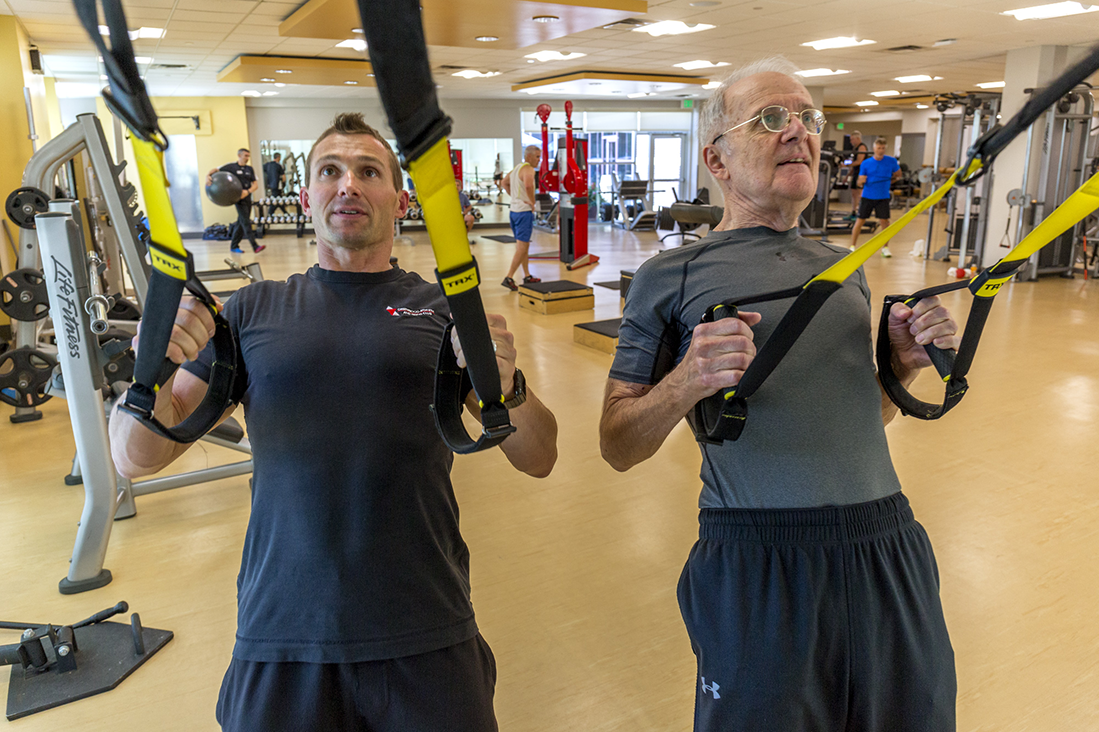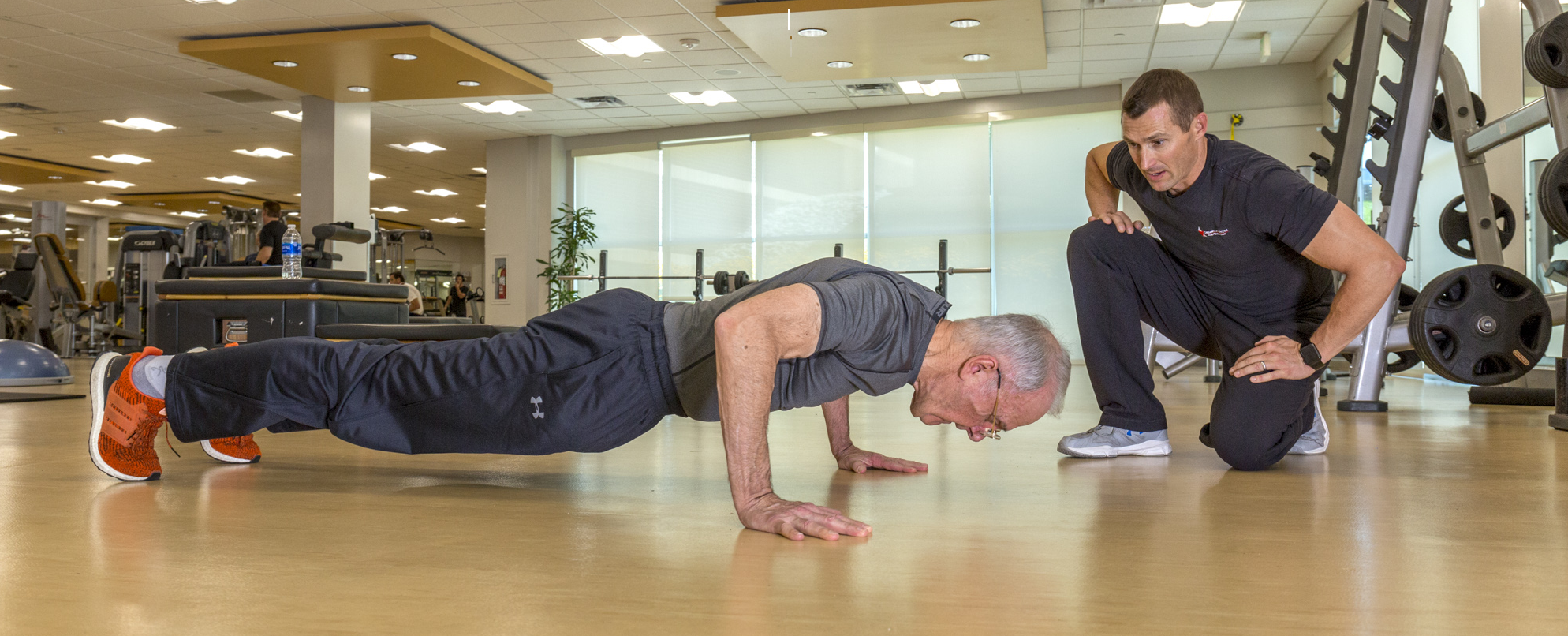
SPOTLIGHT
Where shaping up is about community—and fun
A top trainer at Denver’s Greenwood Athletic and Tennis Club, Joe Talbert gets results by keeping his clients moving and motivated
Can you give me a snapshot of what sets the club apart?
This is a family-oriented place with an unusual range of fitness resources. It has over 7,000 members including kids, 153,000 square feet of indoor and outdoor facilities, and around 30 certified trainers, all of whom are employees of the club. We also have nutritional counseling, physical therapy, massage, and other services on site.
I’ve been a personal trainer here since 1999, ever since I got out of college. I also manage the PWRFIT high-intensity interval training classes. But my job is really to connect members with all the resources they need, both inside and outside the club.
What led you to make training your career?
I was an athletic trainer while attending the University of Northern Colorado, so I learned about sports medicine and injuries as well as fitness. Working with athletes is rewarding because you can see the benefits of your training on the field. The problem is, it’s limited. Here I get to work with many kinds of people and a variety of training systems.
What is your philosophy for working with older members?
In my experience, older people hate workout classes that are tailored for their age group. People who want to be fit like doing the same things younger people are doing, modified if need be.
A lot of our members are very committed. The average age of our members is close to 50, and it’s incredible how much focus some of them give to being fit. Our goal is to help them live well for the next 50 years.
What’s the path to fitness for new members who wants to get in better shape?
First, we assess and score their ability to move functionally. I also ask them to do one of my PWRFIT classes while wearing a heart monitor. If they’re doing a squat and their heart rate is at the max, they are probably not very fit.
No matter how old you are or what shape you’re in, you’re going to need a multifaceted approach. You’ll need to have balance, be able to lift things, walk across the parking lot. You’ll need flexibility, which you can build in various ways; some strength moves improve flexibility, too. And, of course, cardio, which doesn’t necessarily require all that much time, as research has proved.
For the strength training component, we start with bodyweight exercises. If you’re got injuries or weaknesses, we can use machines to greatly reduce the weight if need be. Say you have a bad knee. Rather than doing a bodyweight squat, we’ll start with a leg press machine so we can use minimal weight and build from there, or use TRX straps so you get some help from your arms.
“If you’re dedicated, you can become pretty fit within three to six months, whatever your age… It’s incredible how quickly your body can change if you are consistent.”
Are there some movements or exercises you recommend specifically for training clients over 50?
One thing the older generation can find difficult is being able to stop your body once it’s in motion. If you trip you need to be able to catch yourself. It’s a nervous system response more than a strength response. So I always recommend two things. One is take off those padded athletic shoes and spend some time going barefoot, so you can feel how it is to balance by more fully engaging the muscles of your feet and legs. Number two, learn how to decelerate. Stand on a low box and simply jump off. You should be able to land on your feet and have your body absorb the shock without thinking about it.
How long does it typically take an older member to get fit?
If you’re dedicated, you can become pretty fit within three to six months, whatever your age. Our Clean 30 program is very popular. It combines a clean diet, cardio, and strength exercises, and I’ve seen people get amazing results with it. It’s incredible how quickly your body can change if you are consistent. Three months can be transformative.
What does a complete shape-up program look like?
Working in a variety of modes is important. It’s not a good idea to ask older members to go a hundred and ten percent every time. So I advise my training clients to pick two days a week to go hard with a PWRFIT class or spinning class. We do personal strength training once or twice a week; it’s hard to keep things fresh if you do any more than that. On recovery days, do something to stay in motion. Work on functional fitness, flexibility, foam rolling, maybe add Pilates.
The best setup for success is having as many touches as possible each week. Ideally my clients are doing something active every day. Monitoring is also important. I use a heart rate app during strength and PWRFIT workouts to provide instant feedback on how hard my clients are working. I also see weekly and monthly totals. If you want to improve, you need to get comfortable with being uncomfortable. That’s how you get stronger and better.

What are the best ways you’ve found to motivate your clients?
Group training is at the top of my list. While my initial training sessions with a client are one on one, after that I like them to work in duos, trios, or quads—it’s way more motivating. We do three or four exercises in a circuit-style format, so it’s like a mini-class, only you’re getting more attention. It becomes your community, so you’re not going to miss a session. Husband-and-wife training is another big one. It’s a way of spending time together, like a date, and we can be running two different programs at once.
Above all, I try to keep it fresh and make it fun. In a gym like this, you’ve got a whole community and a lot of energy to help keep you going.
Do people really need a gym membership and a trainer to get fit?
You can certainly get fit without a trainer, but there’s no substitute for the community and the resources in a club like this one. Working out at home is never going to be as much fun as being in a community setting where you’re absorbing information, seeing what others are doing, and maybe feeling that little spark of competition. Working out in a gym is also the best way to learn good movement form. You’re not going to get that from a video.
Membership here includes 122 classes of every kind you can think of. You can walk in the door and do any of them, or use the weight rooms, basketball courts, tennis courts, indoor and outdoor pools. You don’t necessarily have to make an appointment with a personal trainer. You might prefer Pilates, for example, which is another whole movement system that doesn’t require being in the weight room at all. There are a lot of different ways to get the results you want.